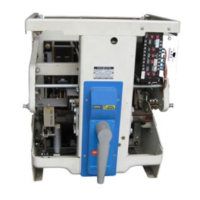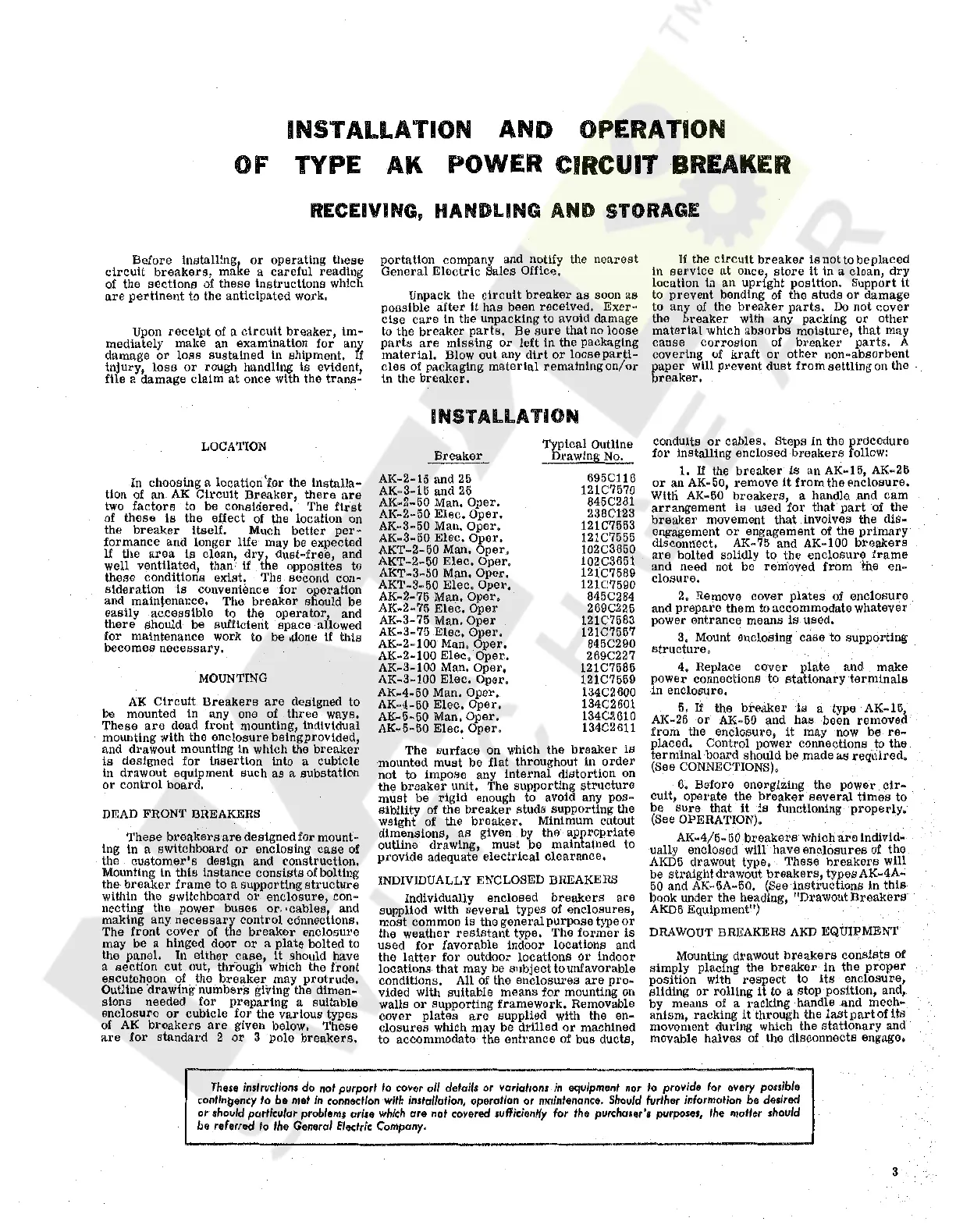INSTALLATION AND OPERATION
OF
TYPE
AK
POWER CIRCUIT BREAKER
RECEIVING,
HANDLING
AND
STORAGE
Before installing
or
operating these
circuit
breakers,
make a careful reading
of
the sections
of
these instructions which
are
pertinent
to the anticipated work.
Upon
receipt
of
a
circuit
breaker,
im~
mediately make an examination for any
damage or loss sustained ln shipment.
If
injury,
loss
or
rough handling
ts
evident,
ftle a damage claim
at
once with the transM
LOCATION
In choosing a location
1
f.or
the installa-
tion
of
an-
AK
Circuit
Breaker,
there
are
two
factors
to be considered, The
first
of
these
is
the effect
of
the location
on
the
breaker
ltseU. Much better
per~
formance and longer life may be expected
U the
area
ls
clean, dry
dust~free,
and
well ventilated, than:
if
the opposites to
these conditions exist. The second con-
sideration
is
convenience for operation
and maintenance, The
breaker
should be
easily acicesslble
to
the operator, and
there
should be sufficient space allowed
for maintenance work to be ,pone
if
this
becomes
necessary.
MOUNTING
AK
Circuit
Breakers
are
designed to
be mounted in any one
of
three
ways.
These
are
dead front mounting, individual
mounting with the enclosure being provided,
and drawout mounting in which the breaker
is
designed for insertion into a cubicle
in drawout equipment such as a substation
or control board.
DEAD FRONT BREAKERS
These
breakers
are
designed for mount-
ing in
a swttchboard
or
enclosing case
Of
the
customer's
design and construction.
Mounting ln this instance consists
of
bolting
the
breaker
frame to a supporting
structure
within the switchboard or enclosure,
con~
necting the power buses or. •cables and
making any
necessary
control cdnnechons.
'rhe front cover
of
the
breaker
enclosure
may be a hinged door or
a plate bolted
to
the panel.
In
either
case,
it
should have
a section cut out, thiOugh which the front
escutcheon
_of
the_
br_eaker may protrude.
Outline 'drawing· numbers
glVing
the dimen-
sions needed for
preparing
a suitable
enclosure
or
cubicle for the various types
of
AK
breakers
are
given below. These
are
for standard 2 or 3 pole
breakers.
portaUon company and notify the
nearest
General Electric Sales Office.
Unpacli;:
the
circuit
breaker
as
soon
as
possible after
tt
has been received.
Exer~
else
care
in the unpacking to avoid damage
to
the breaker
parts.
Be
sure
that
no
loose
parts
are
missing
or
left in the packaging
material. Blow out any
dirt
or
loose
parti-
cles
of
packaging material
rematnlngon/or
in the breal{er.
INSTALLATION
Breaker_
AK-2~15
and 25
AK-3-15 and
25
AK
..
2-50
Man.
Oper.
AK-2-50
E!ec.
Oper.
AK~3~50
Man. Oper.
AK~3~50
Elec. Oper.
AKT-2-50
Man.
Oper,
AKT-2p50 Elec, Oper,
AKT-3~50
Man,
Oper.
AKT-3-50
Elec.
Oper.
AK-2-75
Man. Oper,
AK-2-75
Elec.
Oper
AK-3-75 Man. Oper
AK-3-75
Elec,
Oper.
AK
..
2-100 Man. Oper.
AK-2-100
Elec,
Oper.
AK-3-100
Man.
Oper.
AK-3-100
Elec.
Oper.
AK-4-50
Man, Oper.
AK-4-50
Elec.
Oper.
AK-5-50
Man,
Oper.
AK-5-50
Elec. Oper.
Typical Outline
Drawing
No.
695Cl16
121C'7570
845C281
238C123
121C7553
121C7555
102C3650
102C3651
121C7589
121C7590
845C284
269C225
121C7583
12!C7557
845C290
269C227
121C7585
!21C7559
134C2600
!34C2601
134C26!0
134C2611
The surface
on
which the
breaker
is
mounted must be flat throughout in
order
not to impose
any
internal distortion
on
the
breaker
unit, The supporting
structure
must be rigid enough to avoid
any
pos~
sibility
of
the
breaker
studs supporting the
weight
of
the
breaker,
Minimum cutout
dimensions, as given
by
the appropriate
outline drawing, must be maintained
to
provide adequate
electrical
clearance.
INDIVIDUALLY ENCLOSED BREAKERS
Individually enclosed
breakers
are
supplied with
several
types
of
enclosures,
most common is the general purpose type
or
the weather
resistant
type, The
former
is
used
for
favorable indoor locations
and
the
latter
for outdoor locations
or
indoor
locations that may be subject to unfavorable
conditions, All
of
the enclosures
are
pron
vtded with suitable means
for
mounting
on
walls
or
supporting framework. Removable
cover plates
are
supplied with the en-
closures which may be drUled
or
machined
to accommodate the entrance
of
bus ducts,
If
the
circuit
breaker
is
not to be placed
in
service
at
once,
store
it
tn a clean,
dry
location in an upright position. Support
it
to
prevent bending
of
the studs or damage
to any
of
the
breaker
parts.
Do
not cover
the breaker with any packing
or
other
material which absorbs moisture, that may
cause corrosion
of
breaker
parts.
A
covering
of
kraft
or other non-absorbent
paper will prevent dust ·from settling
on
the -
breaker.
conduits
or
cables. Steps in the procedure
for installing enclosed
breakers
follow:
1.
If
the breali;:er is an AK-15, AK-25
or
an AK- 50, remove
it
from the enclosure.
Witli AK-50
breakers,
a handle and cam
arrangement is used
for
that
part
of
the
breaker
movement that involves the dis
..
engagement
or
engagement
of
the
primary
disconnect.
AK~75
and AK-100
breakers
are
bolted solidly to the enclosure
frame
and need not be removed from
~he
en-
closure,
2. Remove cover plates
of
enclosure
and
prepare
them
to
accommodate whatever
power entrance means
is
used.
3,
Mount
enclosing case to supporting
structure,
4. Replace cover plate and make
power connections
to
stationary
terminals
in enclosure,
5,
If
the
breaker
is a type AK-15,
AK-25
or
AK~50
and has ·been removed
from the enclosure, it inay
now
be
re-
placed. Control power connections
to
the
terminal board should be made as
req\.~lred,
(See CONNECTIONS),
6. Before energizing the power
cir
..
cult, opel'ate the
breaker
several
times
to
be
sure
that
it
is
fUnctioning ·properly.
(See OPERATION),
AK-4/5.
50
breakers
Which avo
indlvid·
ually enclosed will have enclosures
of
the
AKD5
drawout type, These
breakers
will
be straight drawout
breakers,
types AK-4A-
50
and
AK~5A-50.
(See instructions in
this
book under the heading,
11
Drawout
Breakers
AKD5 Equipment'')
DRAWOUT BREAKERS
AKD
EQUIPMENT
Mounting drawout
breakers
consists
of
simply placing the
breaker
in the
proper
position with
respect
to
its
enclosure,
sliding
or
rolling
it
to a stop position, and,
by
means
of
a racking handle and mech
..
anism, racking
it
through the
last
part
of
its
moven1ent during which the stationary and
movable halves
of
the disconnects engage.
The$e
inslruction$ do
nol
purport
lo cover
all
detail$
or
variations
in
equipment
nor
lo
provide
for every pouible
contlntJency
lo
be met
In
connecflon
with
instal/cdion, operallon
or
maintenance.
Should
further
information
be de$ircd
or
should
particular
problems arise
which
are
not
covered sufficienfly for
the
purchaser'1
purpose1,
the
matter
should
be
reFerred
to
the
General
Electric;
Company.
3
Courtesy of NationalSwitchgear.com

